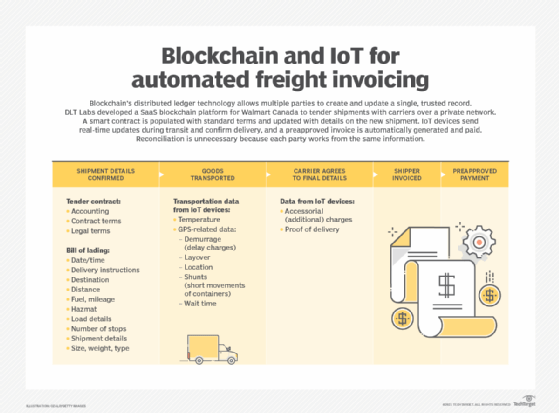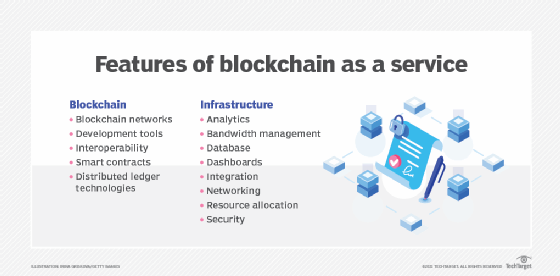Blockchain is essentially a database technology with attributes that, taken alone, are not unique to it, but which collectively produce a technological breakthrough in how digital information is stored, verified and exchanged.
When the technology hit the scene in 2009 with the release of its first application, the Bitcoin cryptocurrency, blockchain had a Wild West feel akin to the early days of PC hackers, making the technology seem risky and unproven for business use. That began to change about five years ago when a burgeoning open source community began developing complete enterprise platforms, including the programmable blockchain, Ethereum.
Expectations for enterprise blockchain were sky-high to begin with, but the reality fell far short of the hype, and business blockchain projects were few and far between.
In the past two years, as household brands like Bumble Bee Foods, IBM, Walmart and Visa have proudly touted successful blockchain deployments, blockchain is getting a second chance at relevance in the enterprise. IT heavyweights including Amazon Web Services (AWS), IBM, Oracle and SAP have gotten behind it in a big way. Is blockchain ready for success in the enterprise?
“I would say we’re still in the early stages,” said Martha Bennett, vice president and principal analyst at Forrester Research. “I do have examples of where real processes are running in real operational environments and there is no fallback option.” She named an interbank reconciliation application in Italy as an example.
But caution is warranted. Using blockchain for business applications will not be easy. Its technical underpinnings and their practical implications are difficult to grasp. That’s true even for tech-savvy business leaders with a working knowledge of, say, ERP or e-commerce. For starters, blockchain is laden with concepts like consensus algorithms, hashing, distributed ledgers and bitcoin mining. These obscure-sounding terms aren’t just under-the-hood details that only techies need to understand. They are the very thing that determines whether blockchain is worth considering at all, which applications it’s best suited for, and the cheapest, most effective ways to implement it.
The key is to have an accurate picture of what blockchain really does and doesn’t do; the effects of its various deployment options, especially its network architectures; and where the heavy black lines are between blockchain and possibly better alternatives. That’s the only way to get value from blockchain and avoid wasting money on spectacular failures.
This overview is a good start. Be sure to click on the links throughout the blockchain guide for details about blockchain technology and implementation.
How does blockchain work?
Most of blockchain’s key attributes come from being a type of distributed ledger technology (DLT). Ledgers have been used for centuries to record financial transactions, in recent decades in digitized form in ERP and other business software.
In contrast to those centralized approaches, DLTs distribute copies of the ledger to the nodes on a blockchain network, making each one responsible for recording new transactions and participating in a consensus mechanism to agree on updates to the ledger.
Blockchain’s unique data format is another differentiator and what makes it a particular kind of DLT. Traditional databases store data in rows, columns and files, while blockchain stores it in blocks that are linked together and protected by cryptography.
The data block and transaction-verification mechanisms make it nearly mathematically impossible to hack a blockchain to change data or disrupt transactions. There’s no central authority for malicious actors to target, no one player who can take data private or change the rules without agreement, or whose failure can bring the whole network down. The multiple copies provide data redundancy and transparency.
That’s how blockchain achieves what’s known as immutability: The ledger is permanent and tamperproof and can therefore be trusted. Trust is another key attribute of most forms of blockchain. In human interaction, trust means you don’t have to take extra steps to check if the information presented is true, such as asking an authority figure to validate it, or only interacting with like-minded people you believe to be trustworthy. Similarly, you can trust that the information in a blockchain is accurate — most of the time.
As with pretty much every major computer technology, the picture with blockchain is complicated. Blockchain isn’t always uncrackable. Its security and privacy levels, not to mention usefulness, depend heavily on whether the blockchain runs on a public or private network. And widely available blockchain alternatives provide some of its benefits, such as data security and storage, with less technical risk and cost.
Why is blockchain important for business?
Investing in enterprise blockchain will likely become essential simply for competitive reasons. Just as corporations paid serious mind to breakthroughs like the PC revolution of the 70s and 80s and the mid-90s boom in the World Wide Web, knowing their competitors were taking advantage of these innovations, many experts believe blockchain will command the same attention. Indeed, FOMO — fear of missing out — is probably the biggest motivation behind the new wave of interest in blockchain business applications.
But as you’ll learn in the sections below, herd mentality is not the only thing driving blockchain. The technology shows real potential today to reduce IT costs, expand B2B and B2C networks, enable new products and build wealth. Moreover, blockchain’s business value is expected to increase as enterprise implementations proliferate and are refined.
How can blockchain benefit businesses?
Enterprise blockchain really comes into its own in processes that involve multiple parties, all of which need access to the same data, but each has slightly different or out-of-date information, “and an enormous amount of time is spent reconciling data,” Bennett said.
Because blockchain removes middlemen and mostly automates processes that often take time and effort, it has the potential to save businesses IT and labor costs, speed up e-commerce and finance and enable new lines of business. It can also help businesses expand their customer bases, reach them more efficiently, and expand the universe of suppliers and partners.
Blockchain benefits primarily derive from the trust it fosters, its built-in privacy, security and data integrity and its transparency.
Trust makes it possible to do business with unknown parties, thereby expanding markets and potentially the demand for products and services, which in turn can boost profits.
Being able to trust the accuracy of the data and believe that the system itself is essentially impermeable, and that in most cases privacy is assured, can reduce fraud, eliminate data leaks and, like trust, bring in more customers and partners. It can also cut data management costs, boost data accuracy and facilitate auditing.
The transparency of blockchains has benefits in supply chain management, visibility and traceability. Blockchain is already making it easier and more affordable to extend supply chain transparency to the smallest suppliers, such as coffee growers, tuna fishing operations and miners, while shoring up trust in information about product provenance as the goods move through the supply chain to consumers.
Other blockchain benefits to enterprises include the following:
- tokenization, which makes more asset classes tradeable online, from digital art to carbon credits to industrial machinery;
- innovation, when blockchain’s special qualities are applied to old problems like verifying academic credentials; and
- decentralization, which is helpful when businesses must interact as peers but no one wants responsibility for maintaining the system, as in supply chains and research communities.
What are blockchain applications for businesses?
Arguably the most important application of blockchain for business could be smart contracts, which play a dual role as foundational components of blockchain infrastructure and software development and as an application of the technology.
A smart contract is most easily understood as a program that uses business logic to execute agreements and transactions between blockchain participants. A similar term, smart legal contracts, means something entirely different: Smart legal contracts, some elements of which are executed in software, typically don’t involve blockchain. Meanwhile, the legal status of blockchain smart contracts is an open question.
Smart contracts have many uses in business. They can completely automate the exchange of money and delivery of services, granting of access to digital content and enforcement of privacy protections.
For example, a blockchain freight-invoicing application deployed by Walmart Canada uses smart contracts to pull live shipment data into invoices and send preapproved payments once the terms of the shipping agreement are met (see image, “Blockchain and IoT for automated freight invoicing”). Bennett called it a “poster child” for how a well-designed blockchain application can save significant time and money by minimizing data reconciliation processes and disputes.

Here are other blockchain applications with business uses:
- Cybersecurity. Blockchain’s strong encryption and other security safeguards make it another tool in the security toolbox.
- Cryptocurrency. Bitcoin and other digital currencies have moved past the fad stage as high-profile companies like Tesla add it to their investment portfolios and accept it as payment for some products.
- IoT. Blockchain is ensuring the integrity of data collected from sensors as it moves up the supply chain from fields and factory floors in applications for asset management, environmental compliance and traceability. It could also free up machine-to-machine communication so semi-autonomous machines can order their own replacement parts and pay for maintenance.
- Storage. Blockchain’s decentralized, peer-to-peer architecture makes it possible to piece together the unused disk space of blockchain participants, creating blockchain storage.
Blockchain use cases in real-world industries
Blockchain use cases tend to cluster in industries that are deep-pocketed and have tech-savvy market leaders who can make the business case for, then implement, blockchain business applications, which typically require substantial coordination and transactions among numerous partners or even competitors.
Examples of sectors that are finding uses for blockchain include the following:
Supply chain. Blockchain expands the number of suppliers and buyers and ensures the integrity of data passing through the supply chain, thereby getting closer to the elusive goals of supply chain visibility and transparency;
Banking and finance. Blockchain use cases in finance fall into two distinct segments: cryptocurrency and decentralized finance, or DeFi. Cryptocurrency is gaining credibility as an alternative payment mechanism in a world monetary system that is largely run by government central banks and big payment providers, such as Mastercard and Visa. At the same time, DeFi is emerging as a potential replacement for other processes traditionally handled by banks and financial service providers, namely credit, insurance, banking and investments. By using smart contracts, individuals might be able to lend each other money, pay interest, insure against loss and trade asset derivatives.
Some observers predict these applications will bring about a “blockchain economy” in which cryptocurrency has largely replaced today’s monetary systems and people and machines manage business processes and exchange value without intermediaries.
Healthcare. Blockchain security, privacy, data integrity and anonymity could enable new uses of individuals’ genomic data and medical records to support pharmaceutical research and make it easier to transmit electronic medical records.
Government. Blockchain could make it easier — and legal — to transmit personal identification electronically, vote online, acquire a passport and prepare legal documents and regulatory filings, such as mortgage deeds and financial reports.
What are the different types of blockchain technology?
The different types of blockchain are categorized by how open or closed they are to letting participants do the main work of the blockchain: i.e., transact business on it or verify the accuracy of each block that gets added to the blockchain and distributed ledger.
Here are the major types:
- Public (permissionless) blockchain does not require permission to join and is transparent to all participants. It’s the kind of blockchain where cryptocurrency lives. It’s also the slowest because opening the blockchain’s consensus process to so many participants makes data verification more tedious — but also less vulnerable to hacking or control by a dominant actor.
- Private (permissioned) blockchain runs on a closed network and might be under the control of a single entity. It has the same decentralization and peer-to-peer architecture as public blockchain but on a much smaller scale, which boosts performance. Ironically, trust is weaker than on a public blockchain because the owner or central node decides what’s valid. Security can also be weaker because it’s easier for a small number of nodes to dominate the consensus mechanism used to validate transactions. Most of the early high-profile blockchain deployments are on private blockchains.
- Hybrid blockchain, unsurprisingly, combines aspects of public and private blockchains. Organizations can use it to segment some data and transactions behind a permission scheme while maintaining connections to the public side. The blockchain security risks and data integrity issues of private blockchain are mitigated by not allowing the owner to alter transactions, and performance tends to be better than a public blockchain’s. Users joining a hybrid blockchain have privacy until they enter into a transaction.
- Consortium blockchain is a lot like private blockchain, but it’s controlled by a group instead of a single entity. There’s less security vulnerability than is typical with private blockchain, though one node is responsible for validating transactions.
There is much disagreement among enterprise blockchain experts about the permissioned vs. permissionless choice. It’s undeniable that most of the successful deployments so far have been on private blockchains, presumably because corporations wanted control over who can participate, and the most prominent open source platforms cater to private blockchain development.
But Paul Brody, the global blockchain leader at consulting firm EY, says public blockchains are best because they encourage the high participation rate that will make blockchain networks valuable. He wrote an article in this guide on how to implement blockchain.

What are the risks and challenges of blockchain adoption?
Adopting blockchain for serious enterprise use carries above-average risks of choosing the wrong platform, incurring project cost overruns and delays, and failing to achieve positive ROI.
“There is still a lot of risk averseness and a reluctance to do something differently,” Bennett said. “People are prepared to continue with suboptimal processes simply because they know what they need to do even if it’s cumbersome, and they don’t want to take the leap.”
Other common blockchain challenges include the following:
- Lack of adoption: Blockchain, especially public blockchain, requires a large number of participants for most of its benefits to be realized. Until more companies are willing to take the leap and try out blockchain, those that do are likely to find a small universe of trading partners waiting for them, according to market researchers.
- Skills gap: Blockchain know-how is in short supply, though that’s rapidly changing as training and certification rises along with the demand — and salaries — for blockchain developers and engineers.
- Lack of trust: Blockchain is still so new that many businesses won’t have confidence in its unfamiliar security and data-integrity mechanisms. In response, they’ll want to control the system in a private blockchain but will lose some transparency and data redundancy in the process.
Bennett said the blockchain community faces a challenge in asset tokenization in fields that are subject to fraud, such as fine wines. “There does need to be a whole framework of some form of trusted third parties that provide attestations at the point of tokenization and as the asset moves through the supply chain,” she said. In addition, many countries’ laws don’t recognize the concept of owning an asset that lacks a physical representation.
Blockchain implementation best practices
Achieving quick ROI from what are likely to be expensive blockchain projects requires an acute sense of blockchain’s unique benefits and focusing only on problems that it’s best suited to solve.
 Paul Brody
Paul Brody
That usually entails taking full advantage of smart contracts and tokenization, according to EY’s Brody, which in turn means fully appreciating the programmability and automation available in smart contracts, and not confusing their use with moving documents back and forth. Tokens are the means for moving value rather than information, which is essential to realizing blockchain’s potential, Brody stressed.
He advised not obsessing over finding the best technology and instead going for the network with the most users. Blockchain and smart contracts make it possible for multiple parties to share business logic and transact more business automatically.
Finally, don’t use blockchain to fix a problem already solved with another technology. It’s a waste of resources and adds risk.
Blockchain deployment options
Over the technology’s short history, deploying blockchain has been a heavy lift for most companies. It requires substantial up-front design work, technology selection, software development and testing. Companies typically run pilots, only a fraction of which go into production.
Blockchain as a service providers offer a shortcut by packaging the smart contract technology, blockchains and network infrastructure they run on. BaaS has emerged as a popular choice because it removes much of the legwork of setting up a blockchain. Prominent BaaS players include AWS, IBM, Oracle, SAP and VMware.
Blockchain tools and vendor market
The number and quality of blockchain platforms with enterprise-class blockchain development tools and architectures has reached a point where most companies can find a suitable platform and supportive community of developers and system integrators.
 Suseel Menon
Suseel Menon
Here are the top three platforms for enterprise blockchain, according to Suseel Menon, a senior analyst at Everest Group.
Ethereum is an open source community that offers one of the oldest blockchain platforms (it was introduced in 2013) and the one with the most support from developers and IT vendors, with companies like Cisco, Intel, J.P. Morgan, Mastercard, Microsoft, Samsung, Toyota and Visa participating in a 250-plus member alliance. It bills itself as a programmable blockchain, which is an apt description. Ethereum provides the underlying network, and the blockchain itself, comparable to the one that Bitcoin is on. Ethereum has a competing cryptocurrency called Ether that plays an additional role as the exchange medium and token for all operations on the network, but the platform’s greatest relevance to enterprises is its wealth of tools for developing smart contracts and blockchain decentralized applications (dApps). Ethereum also provides a marketplace for applications, including games and financial services, and exchanges for nonfungible tokens (NFTs), a newly popular type of digital asset on blockchains.
Hyperledger is another open source community that benefits from backing from the Linux Foundation, the consortium behind the popular Linux operating system, as well as from Intel, SAP Ariba and IBM, which uses Hyperledger as the basis for its BaaS offering. The platform has a strong focus on private blockchains for enterprises, with extra features for enforcing privacy, and provides frameworks, development tools and software libraries of components that companies can plug in to build applications. Hyperledger’s name underscores its emphasis on distributed ledgers. Hyperledger Fabric is the modular DLT platform behind many blockchain projects. Another popular tool, especially for supply chain uses, is Hyperledger Sawtooth, which abstracts the application layer from the underlying core architecture so companies can focus on writing the business rules for smart contracts. Sawtooth also has alternative consensus algorithms that can improve blockchain performance.
Corda, from the R3 Consortium, is billed as a private, permissioned blockchain for DLT applications, though others debate whether it’s a true blockchain because it doesn’t batch transactions in blocks. R3 claims its way of linking transactions performs better than the traditional method. Corda is popular in financial services. It counts Bank of America and HSBC as proponents and is getting strong interest from insurers.
The fast-growing market in blockchain tools and services ebbs and flows. For example, Microsoft’s Azure cloud computing division said it will retire its BaaS offering in September.

Blockchain jobs, roles and responsibilities
Blockchain is still very much an emerging technology, and the skills needed to develop and use it are in short supply. In a survey of supply chain managers by APQC, a process-improvement and benchmarking association, 49% said the blockchain skills gap was among their biggest challenges.
Blockchain developer and blockchain engineer are two common job titles, analogous to the development and engineering roles that have long defined general software and web development, but with blockchain-specific skills added, such as experience using the major open source platforms, especially Ethereum and Hyperledger. Some blockchain developers specialize in dApps and smart contracts, while others focus on the plumbing, such as cryptography and consensus algorithms. Most also need to have web development and cloud infrastructure skills, such as Java and Kubernetes experience.
The online job board Cryptocurrency Jobs, which also serves the enterprise blockchain market, recently listed 236 developer and engineer jobs out of 727 postings.
There are also user experience designers who work on the look and feel of dApps and web developers to program web applications that incorporate blockchain. Data scientists and financial analysts are also hired for blockchain projects.
Training for these jobs is available online and in secondary education, as are certification programs.
What is the future of blockchain?
As the world begins to emerge from the COVID-19 pandemic, the blockchain landscape is alive with activity and optimism, and real-world deployments are getting too numerous to count. Companies still feeling the shock of severe supply chain disruption are looking anew to blockchain as a route to greater transparency and responsiveness.
While exorbitantly priced and ridiculous-sounding NFTs make the evening news, enterprise blockchain developers see more important opportunities in expanding tokenization to create new forms of identity verification (vaccine certificates are one early application) and digital commerce.
“There are probably a lot more tokens in blockchain applications today than many people realize,” Bennett said. “In many of the track-and-trace applications that are live today, some of those already represent the asset that’s being tracked as a token.”
Meanwhile, cryptocurrency is finally going mainstream.
Among the most promising of these blockchain trends is the merging of AI with blockchain. AI has always needed copious amounts of data to apply its machine learning algorithms to recognize patterns, predict future outcomes and “learn” to take over tasks for humans. Blockchain could potentially unleash a torrent of new data, in part by providing the privacy and security users need to feel confident sharing more of their personal information. AI, in turn, could improve the efficiency of blockchain’s cumbersome consensus and verification process.
A lot has to happen before blockchain can replace today’s methods of sharing data and conducting transactions over digital networks. Now that blockchain development tools and frameworks are proving their viability for enterprise applications, that day at least seems more like a real possibility than a distant mirage.
